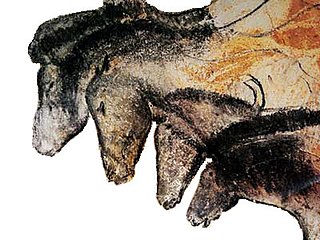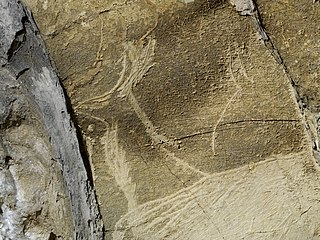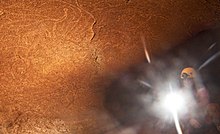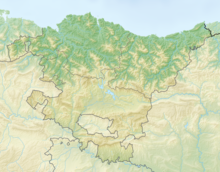
In archaeology, cave paintings are a type of parietal art, found on the wall or ceilings of caves. The term usually implies prehistoric origin. These paintings were often created by Homo sapiens, but also Denisovans and Neanderthals; other species in the same Homo genus. Discussion around prehistoric art is important in understanding the history of the Homo sapiens species and how Homo sapiens have come to have unique abstract thoughts. Some point to these prehistoric paintings as possible examples of creativity, spirituality, and sentimental thinking in prehistoric humans.

The Cave of Altamira is a cave complex, located near the historic town of Santillana del Mar in Cantabria, Spain. It is renowned for prehistoric cave art featuring charcoal drawings and polychrome paintings of contemporary local fauna and human hands. The earliest paintings were applied during the Upper Paleolithic, around 36,000 years ago. The site was discovered in 1868 by Modesto Cubillas and subsequently studied by Marcelino Sanz de Sautuola.

The Chauvet-Pont-d'Arc Cave in the Ardèche department of southeastern France is a cave that contains some of the best-preserved figurative cave paintings in the world, as well as other evidence of Upper Paleolithic life. It is located near the commune of Vallon-Pont-d'Arc on a limestone cliff above the former bed of the river Ardèche, in the Gorges de l'Ardèche.

The Magdalenian cultures are later cultures of the Upper Paleolithic and Mesolithic in western Europe. They date from around 17,000 to 12,000 years ago. It is named after the type site of La Madeleine, a rock shelter located in the Vézère valley, commune of Tursac, in France's Dordogne department.

Lekeitio is a town and municipality located in the province of Biscay, in the Spanish Autonomous Community of Basque Country, 53 km (33 mi) northeast from Bilbao. The municipality has 7,307 inhabitants (2019) and is one of the most important fishing ports of the Basque coast. Tourism has an important role during the summer seasons, when the town is a resort with one beach called Isuntza and the nearby Karraspio beach in the town of Mendexa.

The greater Basque Country comprises the Autonomous Communities of the Basque Country and Navarre in Spain and the Northern Basque Country in France. The Prehistory of the region begins with the arrival of the first hominin settlers during the Paleolithic and lasts until the conquest and colonisation of Hispania by the Romans after the Second Punic War, who introduced comprehensive administration, writing and regular recordings.

La Marche is a cave and archaeological site located in Lussac-les-Châteaux, a commune in the department of Vienne, western France. It is an archaeological site that has engendered much debate that has not been resolved to date. The carved etchings discovered there in 1937 show detailed depictions of humans and animals that may be 15,000 years old. The cave paintings at this site, however, are controversial and many doubt their authenticity.

The Hohle Fels is a cave in the Swabian Jura of Germany that has yielded a number of important archaeological finds dating from the Upper Paleolithic. Artifacts found in the cave represent some of the earliest examples of prehistoric art and musical instruments ever discovered. The cave is just outside the town of Schelklingen in the state of Baden-Württemberg, near Ulm. Because of the outstanding archeological finds and their cultural significance, in 2017 the site became part of the UNESCO World Heritage Site Caves and Ice Age Art in the Swabian Jura.

The art of the Upper Paleolithic represents the oldest form of prehistoric art. Figurative art is present in Europe and Southeast Asia, beginning between about 40,000 to 35,000 years ago. Non-figurative cave paintings, consisting of hand stencils and simple geometric shapes, are somewhat older, at least 40,000 years old, and possibly as old as 64,000 years. This latter estimate is due to a controversial 2018 study based on uranium-thorium dating, which would imply Neanderthal authorship and qualify as art of the Middle Paleolithic.

The Cantabrian caves' unique location make them an ideal place to observe the settlements of early humans thousands of years ago. The magnificent art in the caves includes figures of various animals of the time such as bison, horses, goats, deer, cattle, hands and other paintings. Archaeologists have found remains of animals such as bears, the remains of arrows and other material indicating a human presence; these artifacts are now found mostly in the Regional Museum of Prehistory and Archaeology of Cantabria.

Les Combarelles is a cave in Les Eyzies de Tayac, Dordogne, France, which was inhabited by Cro-Magnon people between approximately 13,000 to 11,000 years ago. Holding more than 600 prehistoric engravings of animals and symbols, the two galleries in the cave were crucial in the re-evaluation of the mental and technical capabilities of these prehistoric humans around the turn of the 20th century. In 1979, along with other nearby paleolithic sites and cave paintings, the cave was inscribed on the UNESCO World Heritage List as part of the Prehistoric Sites and Decorated Caves of the Vézère Valley.

The Cave of Altxerri is located in the municipality of Aya (Gipuzkoa) in the Basque Country (Spain).

The Tito Bustillo Cave is a prehistoric rock shelter located in the small town of Ribadesella, in the autonomous community of Asturias, Spain. The cave was inhabited by humans (cro-magnon) before the year 10,000 BC. Due to the collapse of the rock, the original entrance to the cave was sealed thousands of years ago, which made it possible for preservation of objects, tools and wall paintings that were discovered in 1968. Based on those objects found in the cave, it is known that there was a significant human presence during the Magdalenian culture of the Upper Palaeolithic, but the cave was probably inhabited before that time.

The Vogelherd Cave is located in the eastern Swabian Jura, south-western Germany. This limestone karst cave came to scientific and public attention after the 1931 discovery of the Upper Palaeolithic Vogelherd figurines, attributed to paleo-humans of the Aurignacian culture. These miniature sculptures made of mammoth ivory rank among the oldest uncontested works of art of mankind. Because of the cultural importance of these sculptures and the cave's testimony to the development of Paleolithic art and culture, in 2017 the site became part of the UNESCO World Heritage Site called Caves and Ice Age Art in the Swabian Jura.

The La Garma cave complex is a parietal art-bearing paleoanthropological cave system in Cantabria, Spain. It is located just north of the village of Omoño, part of the municipality of Ribamontán al Monte. The cave complex is noted for one of the best preserved floors from the Paleolithic containing more than 4,000 fossils and more than 500 graphical units. It is part of the Cave of Altamira and Paleolithic Cave Art of Northern Spain World Heritage Site.

The small Sirgenstein Cave, German: Sirgensteinhöhle is situated 565 m (1,854 ft) above sea level inside the 20 m (66 ft) high Sirgenstein, a limestone rock. The cave sits 35 m (115 ft) above the Ach River valley bottom in the central Swabian Jura, southern Germany. Archaeologist R. R. Schmidt excavated the site in 1906 during which he identified indices of prehistoric human presence. He recorded the complete stratigraphic sequence of Palaeolithic and Neolithic origin. In his 1910 analysis Schmidt inspired future archaeologists with his pioneering concept of including the excavation site within its geographic region, contextualizing it within a wide scientific spectrum and demonstrated valuable results as he correlated the Sirgenstein layer structure to those of prehistoric sites in France. Mammoth ivory beads dating from 39,000 to 35,000 years ago have been uncovered at the cave. Because of its historical and cultural significance and its testimony to the development of Paleolithic art, the cave was inscribed on the UNESCO World Heritage List as part of the Caves and Ice Age Art in the Swabian Jura site in 2017.

Vasco-Cantabria, in archaeology and the environmental sciences, is an area on the northern coast of Spain. It covers similar areas to the northern parts of the adjacent modern regions of the Basque country and Cantabria. In geology the "Vasco-Cantabrian Basin" or "Basque-Cantabrian Basin" covers the area and the seas off the coast in the Bay of Biscay, an area between the Iberian and European tectonic plates.

The Isturitz and Oxocelhaya caves are an important Paleolithic site where a Neanderthal mandible was found, as well as later modern human finds associated with the Aurignacian, Solutrean and Magdalenian. They also include cave paintings and bone flutes. The caves are located in the Gazetelu hill in the Arberoue Valley in the foothills of Pyrenees, in Lower Navarre, a traditional region of the department of Pyrénées-Atlantiques, southwestern France, part of the French Basque Country.

Paleolithic in the Iberian peninsula is the longest period of its prehistory, starting c. 1.3 million of years (Ma) ago and ending almost at the same time as Pleistocene, first epoch of Quaternary, c. 11.500 years or 11.5 ka ago. It was a period characterized by climate oscillations between ice ages and small interglacials, producing heavy changes in Iberia's orography. Cultural change within the period is usually described in terms of lithic industry evolution, as described by Grahame Clark.






















